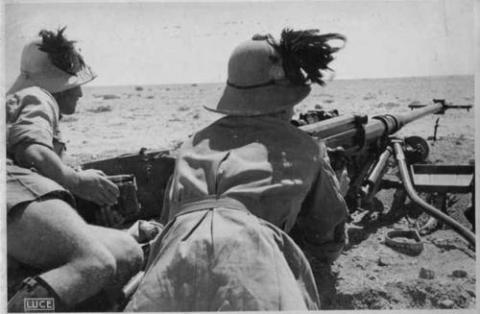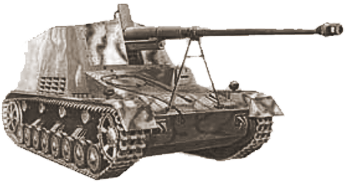The Battle of Gazala

In May of 1942 the British Eighth Army comprised 100,000 Commonwealth soldiers, well equipped, and deployed in depth west of Tobruk along a thirty-five mile frontage. U.S. Lend-Lease aid to Britain had played a prominent role in well equipping Eighth Army. For instance, the British 1st and 7th Armored Divisions included 316 American built tanks. Although 149 were the light Stuart tanks, Eighth Army also fielded more powerful tanks than did Germany, such as 167 of the American M3 "Grant" tanks. The "Grant" featured a hull mounted 75mm gun, and turret mounted 37 mm high velocity gun. That said, though outclassing Axis tanks in the theatre in firepower and protection, the tank proved unwieldy and less than an optimal design. In spite of Allied advantages General Erwin Rommel had prepared to strike the British yet again.
Major General Neil Ritchie commanded the Eighth Army. Though having faced Rommel repeatedly over the prior half year, he had persisted in deploying his forces poorly. For instance, he had failed to concentrate his armor, and forfeited an enormous advantage provided by his army's position in a well-fortified defensive line. Nevertheless, on paper, Ritchie possessed significant advantages over Rommel. For instance, 700 Allied tanks squared off against only 561 Axis tanks. Moreover, only 320 of these tanks were German. What's more these included 50 obsolete Panzer IIs, nearly useless against the British armor. Only four of the long-barreled 75mm Panzer IV "specials" were present in the Axis ranks. Rommel however, enjoyed one advantage; he possessed 48 deadly 88mm guns. In addition though slightly outnumbered in the air, 604 Allied aircraft against 542 Axis aircraft, the 120 German Me-109 fighters available to support Rommel easily outperformed the British Hurricanes and American made P-40 Kittyhawks constituting most British airpower.
On May 26th at 2:00 P.M. Rommel struck the northern portion of Ritchie's defensive line with the Italian XXI and X Corps south of Gazala. Rommel also feinted with his mobile units to draw off British strength. Moving at night Rommel then reversed his path. He flanked Bir Hacheim during the early morning hours on May 27th. Rommel had organized into a potent fist the German 15th and 21st Panzer Divisions and 90th Light Division and the Italian Trieste Motorized Division and Ariete Tank Division. Unfortunately for Rommel's armor, they suffered heavy losses when British tanks lit up the lightly armored German panzers. Although victorious regardless of the initially stiff British resistance Rommel's two panzer divisions shortly thereafter ran headlong into elements from the British 7th Armored Division. The British engaged the German panzers from dug in positions at long range, but the German superiority at the point of contact allowed them to destroy the British forces. The Germans than ran into the rest of the 7th Armored Division and fought this powerful British Division throughout the day and night.
After suffering heavy losses, Rommel was lucky to still have the Afrika Corps in one piece. Nevertheless, the British had committed their armor poorly yet again. Rommel thus gathered his forces and struck west, destroying the isolated Allied 150th Brigade and capturing 3,000 men, 90 tanks, and 100 guns. Rommel then defeated several convoluted and overly intricate British attacks that lasted well into June.
Meanwhile, an intense infantry battle raged at Bir Hacheim where the 1st Free French Brigade and a brigade of Jewish soldiers put up a heroic defense against the German 90th Light Division, Italian Trieste Division and German close air support. Fighting in a "box" defensive position, including well concealed and dug in field fortifications with heavy minefields all around, the French and Jewish defenders offered no weak points to penetrate and although surrounded fought superbly. Finally, after ten days of relentless battle, the defenders broke out and escaped.
On June 11th, Rommel resumed his principal attack. Although absorbing a steady stream of reinforcements Ritchie again suffered defeat when Rommel skillfully deployed his anti-tank guns in conjunction with his armor and decimated the British tank brigades. By June 21st the British armies had begun streaming across the desert in retreat. This time there were no heroics in Tobruk, the British had left it lightly defended. Rommel's men quickly captured the port. British Commonwealth casualties had reached nearly 100,000 men, including 60,000 prisoners of war. Tobruk's loss and the concomitant defeat at Gazala stood among Britain's greatest defeats during the War.
By Steven Douglas Mercatante



Post new comment